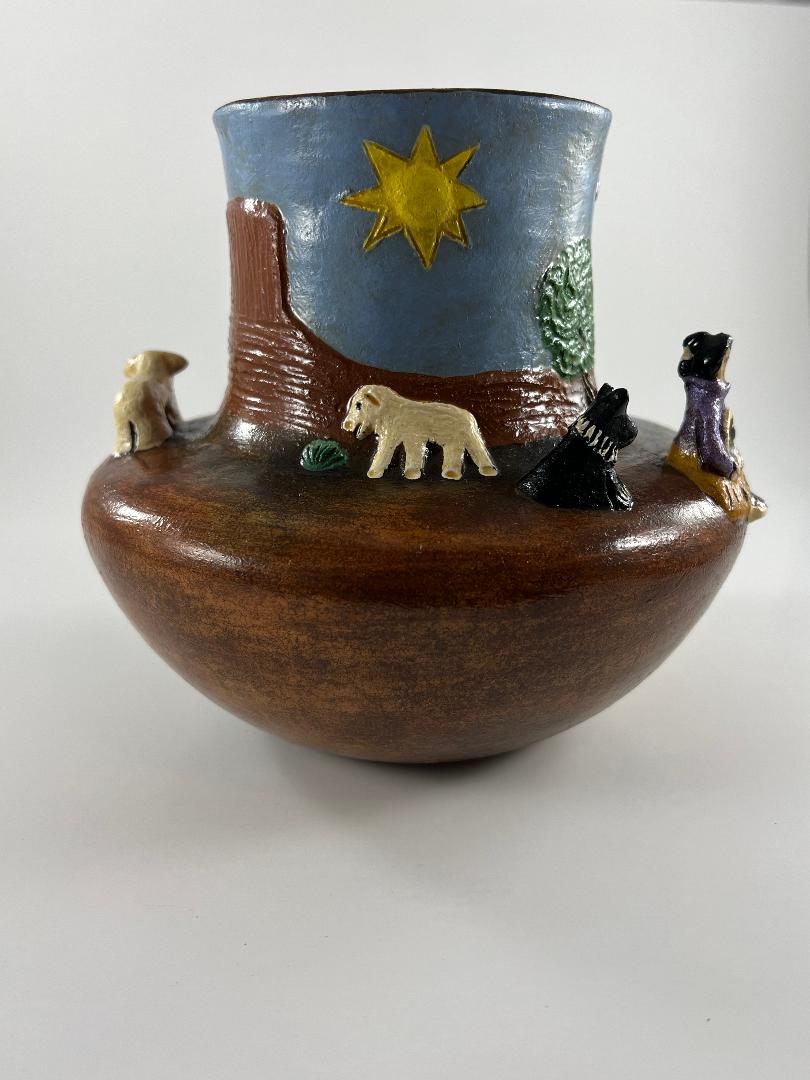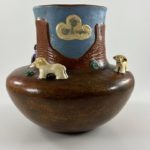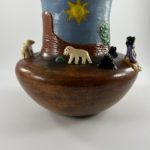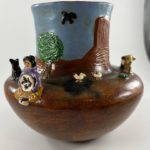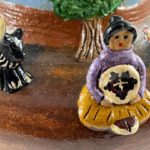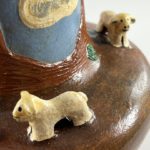Traditional Navajo pottery was utilitarian plainware (cf 1969-07), but with the expansion of roads into the reservation in the 1960’s, Navajo artists began making decorated pots that would appeal to collectors and tourists. Often a a humorous commentary of Navajo life, this work represented a blossoming of folk art on the reservation (Rosenak, 1994). Jar 2021-04 by Betty Manygoats fully represents this trend, and with a smile.
Form:
From a 2.75-inch base, the sides curve sharply upward 3.25-inches, as if to form a bowl. They then curve sharply inward, forming a 1.5-inch wide flat surface before again turning sharply upward for 2.5-inches to form a cylindrical neck with a 3.25-inch wide mouth. The walls of the jar are even and surprisingly thin. The surfaces have been moderately smoothed and covered with pinion pine pitch, the traditional way Navajo use to waterproof their pots. The bottom of the pot is signed “EM” for “Elizabeth Manygoats” and carries the number “20,” indicating it was made in 2020.
Design:
The beauty of the jar, however, is not in its basic form, but in the southwest tableau that Betty has created on its surfaces. I assume that all the colors are acrylic paint.
The exterior sides of the cylindrical neck are decorated with a scene from Monument Valley on a clear day. Against a blue sky two brown buttes grow out of a brown horizon that encircles the jar. A three-lobed cloud floats in the sky between the buttes. To the right of the buttes an eight-pointed sun burns bright yellow. To its right a large black bird flies over a tree with a brown trunk and a globe of green leaves. At ground level, additional figures seem planted on the shelf but are also attached to the exterior sides of the neck. Directly below the sun a white sheep with pink nose, ears and pads of its feet approaches a green bush, perhaps for a snack. Further to the left, an identical green bush awaits. Still further to the left, below the crow, two white chickens with red combs and wattles, black eyes and yellow feet complete the circle. This landscape is not just painted on the pot, but embossed.
All these features above rise a fraction of an inch above the surface of the jar. I have no idea how Betty managed this technique. Perhaps she rolled out a thin sheet of clay and then used an Exact-o knife or some sort of cookie cutter device to cut out each element before then laying them on the surface of the jar and texturing them with a pointed tool. That’s just a guess. However done, this tableau is the backdrop for a cast of three dimensional characters scattered across the ledge-like shelf.
Directly in front of the embossed tree sits a Navajo woman in traditional “dress up” velvet garb holding a “wedding basket” used in ceremonies. Her hair is done up in a bun with a white ribbon. Her purple blouse blends well with her tan skirt; brown boots with white soles protect her feet. To her right (the viewer’s left) a black dog with a white collar and toe nails keeps an eye on his owner. Further to the left are two fully articulated sheep with the division between their legs, ears, eyes, nostrils and mouth marked with black paint. In front of the lead sheep another a green bush grows out of the shelf.
There’s a lot going on here, all of it representing central features of Navajo life on the reservation.
Design analysis:
Most anybody, I think, will react to this tableau with a smile. It’s the nature of folk art to represent central features of life, often reduced to their essential elements, often doing so with humor.
In the summer of 1960, age 15, I had a chance to spend four days living with a Navajo family and their children in their summer hogan located near Navajo Mountain Trading Post in Utah just north of the Arizona border. With typical Native grace, the family treated me like family, including putting me to work. My family back in Connecticut could not have been living a lifestyle more different than that occurring around the brush enclosure where we slept in the desert. When I left Utah I took with me a rapidly expanding sense of both the variety of human life and the possibility of caring across those differences. What a gift that family gave me. It is, of course, a memory that I treasure, and easily recall when I look at jar 2021-04. Grinning.

